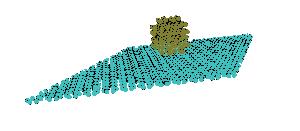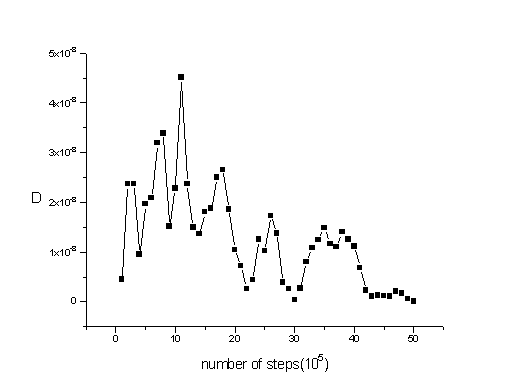

40917-B6
Research in Statistical Physics of DNA Unzipping and Epitaxial Growth
FINAL REPORT FOR PETROLEUM RESEARCH FUND
PRF#40917-B6
Structure and Diffusion of Platinum Clusters on Carbon Surface
Pui-Man Lam
Physics Department, Southern University
Baton Rouge, Louisiana 70813
The structure and diffusion of platinum clusters on carbon
is of interest in the study of fuel cells. Here we consider a two-dimensional
five-sided, honeycomb lattice of carbon atoms. The lattice constant is taken to
be 1.42A. The lattice is held fixed and a platinum cluster is placed on top of
it. The interaction of platinum atoms with the carbon atoms is given by a
Lennard-Jones (LJ) potential, with parameters  and
and  . We start at a high temperature of 1000K. At this
temperature, the platinum cluster is originally taken to be in a spherical
shape containing a fixed number of atoms placed on the lattice sites of FCC
lattice with lattice constant 3.2A. The interaction of the platinum atoms among
themselves is given by the Sutton-Chen potential with parameters: a=3.92A,
. We start at a high temperature of 1000K. At this
temperature, the platinum cluster is originally taken to be in a spherical
shape containing a fixed number of atoms placed on the lattice sites of FCC
lattice with lattice constant 3.2A. The interaction of the platinum atoms among
themselves is given by the Sutton-Chen potential with parameters: a=3.92A,  , c=34.408, m=8, and n=10. The subsequent motions of the
platinum atoms are calculated using a molecular dynamic simulation package
DL_POLY developed by the Daresbury Laboratory in England and freely available
in the internet. A constant temperature algorithm utilizing the Berendsen
thermostat was employed in the simulation. After an equilibration of 5 million
steps, the diffusion constant of the platinum cluster can be calculated from
the shift in the lateral center of mass position of the cluster from its
original position. The final coordinates of the platinum atoms can then be used
as input coordinates for a lower temperature simulation. In Fig. 1 we show the
final configuration of a platinum cluster of 80 atoms after 5 million molecular
dynamics steps. In Fig. 2 we show the diffusion constant D calculated as a
function of the simulation steps.
, c=34.408, m=8, and n=10. The subsequent motions of the
platinum atoms are calculated using a molecular dynamic simulation package
DL_POLY developed by the Daresbury Laboratory in England and freely available
in the internet. A constant temperature algorithm utilizing the Berendsen
thermostat was employed in the simulation. After an equilibration of 5 million
steps, the diffusion constant of the platinum cluster can be calculated from
the shift in the lateral center of mass position of the cluster from its
original position. The final coordinates of the platinum atoms can then be used
as input coordinates for a lower temperature simulation. In Fig. 1 we show the
final configuration of a platinum cluster of 80 atoms after 5 million molecular
dynamics steps. In Fig. 2 we show the diffusion constant D calculated as a
function of the simulation steps.

Fig. 1a. Initial configuration of 80 platinum atoms in the form of a sphere.
 Fig. 1b: Final
configuration of 80 platinum atoms after 5 million steps, at T=1000K.
Fig. 1b: Final
configuration of 80 platinum atoms after 5 million steps, at T=1000K.

Fig. 2 Diffusion constant in units of A2/ps, of a platinum cluster of 80 atoms at T=1000K, as function of time steps.